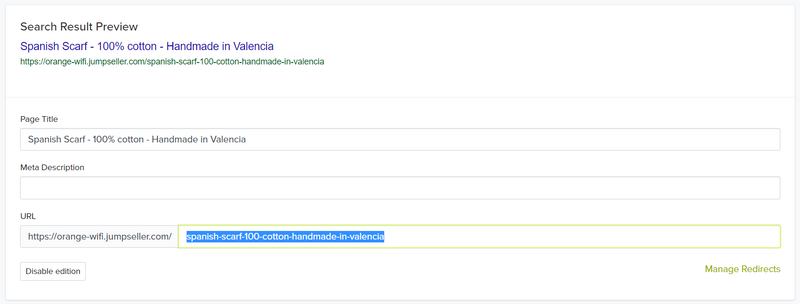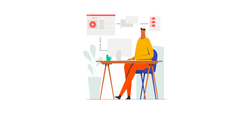Appearing in the top spots of Google can be considered the holy grail of internet marketing.
Being on the first page (without paying for Adwords) represents a huge opportunity to receive visitors to your store who actually have an intention to buy.
This is where SEO (Search engine optimization) comes in! You do not have to be a programmer to configure SEO for your website, in fact, it can be done with relative ease.
Create Search Engine Friendly URLs
When someone clicks on a product, the internet browser displays the URL of your store plus the permalink of your specific product, that is, the text that identifies your particular product within the entire URL.
Although Jumpseller automatically creates an URL based on your page name, you should check if it looks good in the eyes of the search engines and people searching online.
Let’s see a specific example:
Imagine your website is named Scarves X Brand and you have a product whose title is “Spanish Scarf - 100% cotton - Handmade in Valencia”.
In this case, the URL would be very long: “www.scarvesxbrand.com/spanish-scarf-100-cotton-handmade-in-valencia”.
Although it explains what the product is, it has some unnecessary information for an URL.
A search engine friendly URL would be: “www.scarvesxbrand.com/spanish-scarf-100-cotton-handmade” because it shows what your product is about while keeping it short and readable.
You should separate words with “-“, so Google will know that they are different words.
If you use Jumpseller, it’s very simple to personalize your URLs, in the page of the Product, click on “Enable edition” under the “Search Result Preview”, then you can just edit the “URL” field and you’re set.

Use A Canonical URL
First of all, “canonicalization” allows you to tell Google to index and rank a specific article instead of another one.
The other URLs that potentially have similar content and that are serving a similar purpose, or perhaps are exact duplicates, don’t get any importance in searches since you told Google that the info in the others is secondary or irrelevant compared to the Canonical URL.
One common example of this is doing a 301 redirect from one URL to another.
Learn more about the best practises for specifying a canonical page with Google Documentation
Have the Right Keywords
The first step in implementing SEO would be to have the right Keywords. Which means that the keywords are relevant and have a tendency for high volume searches.
It sounds easy but selecting the right keywords to use on your main pages can be tricky, people can use too broad or too competitive keywords which results in a high bounce rate (% of single page visits/sessions that leave without exploring more) for the website.
While another common mistake is to use multiple pages to rank for the same keyword, make sure not to repeat these mistakes.
Some of the tools that can be used to find the right keywords are Google Keyword Planner, KWFinder and Moz’s Keyword Explorer.
Quality Content
This is a very important aspect of SEO that is often overlooked.
Quality content goes a long way in enhancing your ranking on searches, not only that, it brings loyalty and revisits, which in turn can help with customer retention and increased sales.
Try to have original valuable content and not something that is simple there, very similar from other websites, just for the sake of having keyword content.
SEO & Meta-Tags
Jumpseller’s store’s front-end (the themes) are created to be optimized for Search Engines (like Google). Tags like h1, h2, and others, are taken into account to add relevancy to the most important content.
We update all stores’ sitemaps (you can check it by adding “/sitemap.xml” after your store URL, like demostore.jumpseller.com/sitemap.xml) every night in order to index faster your new or updated content on Google.
You can also change, meta-tags and anything else related to your the HTML of your store.
Some techniques to achieve optimization are by optimizing a page’s tags in the HTML code and providing a sitemap for your site.
To increase relevancy in Search Engines, there are tags such as “title”, “H1” and meta tags in Jumpseller themes (HTML code).
These tags are pre-populated with the appropriate store context per page (e.g. using H1 for Product Name on the Product Page).
Meta tags have additional attributes which are pre-populated. However, you can change a meta tag’s attributes and anything else related to the HTML of your store.
Name & Description For Your Products
Many online stores make the mistake of copying both the name and description of the products given by their suppliers.
This makes the same product information repeated in many online stores since many do basically the same thing, and once again, Google will think it is duplicated content.
Create your own names and descriptions. For descriptions, write between 75-120 words, more than that and people will not read it or it won’t show the whole text in the search results.
Another important point is that the names of the products must have the correct format, i.e. have an H1 tag.
This tag gives the Product name a certain ranking within your online store, telling Google which is the most important word on the product page. Doing it right will depend on the technology used in your store.
Quality Link Building
A great way to boost your traffic and your ranking is through quality inbound link building, try to make relations with high quality, authoritative websites and get them to put your link on their pages.
This can be done by finding a way of doing a collaboration with them and it is even better if it can be long term.
There is also some link building software’s out there like Ahrefs and Semrush, use them to be more effective.
Learn more at: Inbound Marketing is the answer.
Audit For Errors
This is a crucial part of the SEO process. It deals with identifying and rectifying the potential errors on your pages.
You may use a reliable online web tool (Screaming Frog and Seoptimer are two good tools for this purpose) to identify the errors or bugs in your website and correct them.
Links that do not work well, such as ones that go to pages that are no longer available, must be removed quickly because these dead links will have a negative impact on the rankings of your websites’ results.
To find out if you have dead links you can use the Google Webmaster Tools and remove these links.
Another useful tool to know if you have links that are not working is Optimizr that allows you to schedule periodic reviews of your online store and automatically check if you have links that are not working.
This will improve the usability of your website as well.
After the website has been cleared of errors and bugs, it is also good to check the speed of your website and make sure it does not take too long to load.
This can be done using various free tools available online like Website Grader or GT Metrix.
Website Structuring
This is central to the whole SEO process and it includes a whole host of things.
Make sure that the keywords and your page outlook are strategically aligned, which means the keywords appear in important locations on the page.
The pages should be user-friendly and not overcrowded with keywords. Find a way to incorporate customer reviews and testimonials (you can add them as sections by using the visual theme editor).
The website design is also important, make sure not to get very complex and intricate, have a balance of beautiful design and ease of use.
This will allow your visitors to have a pleasant experience on your website and make them come back for more.
Also, try to incorporate small things like internal linking (links from one page within your website to another), this can help visitors to explore different areas of the website.
Lastly, make sure all versions of the website are uniformly structured and functioning optimally on their respective platforms. Especially pay attention to the mobile version, as it can cost you many clicks and visitors.
Social Media Integration
Without social media, your website is missing out on a lot. It is a very good way to engage with customers and show your content.
This can help you create a unique relationship with the customers while also increasing your social media following, which can have a huge say about your brand value and to a certain extent, the reliability of your website.
Learn about some of the tools that can help you improve your social media presence.
Blogs
Blogs can be useful in improving the ranking of your site as well. They can also be used to incorporate additional keywords that you were not able to fit on your main pages.
Here you have the chance to use long-tail (more than one word) keywords as well. When it comes to blogs, pay special attention to the content and make sure it is unique and interesting to read.
You can also try to get guest posts with topics related with your website’s sector, so that you may increase the overall quality of your blog.
Evaluating Results
Search engines will “crawl”, that means indexing, your store periodically, so it can sometimes take weeks or even months before you will be indexed at their search results.
Even after that, the search engine has to find your store valuable before ranking it well.
In the first months of your store, you will usually rank low, but over time, by building great content and having links from reputable external websites your ranking will increase.
How Google Crawling & Indexing works.
After a couple of months, it is good to evaluate all the changes you have made and see the results.
Here, you can also use the web tools to highlight where there might be room for improvement. Tools like Google Webmaster and Check My Links are free and very effective in this regard.
Look for areas where you can improve and differentiate from your competitors.
Remember, when it comes to SEO, details matter!





